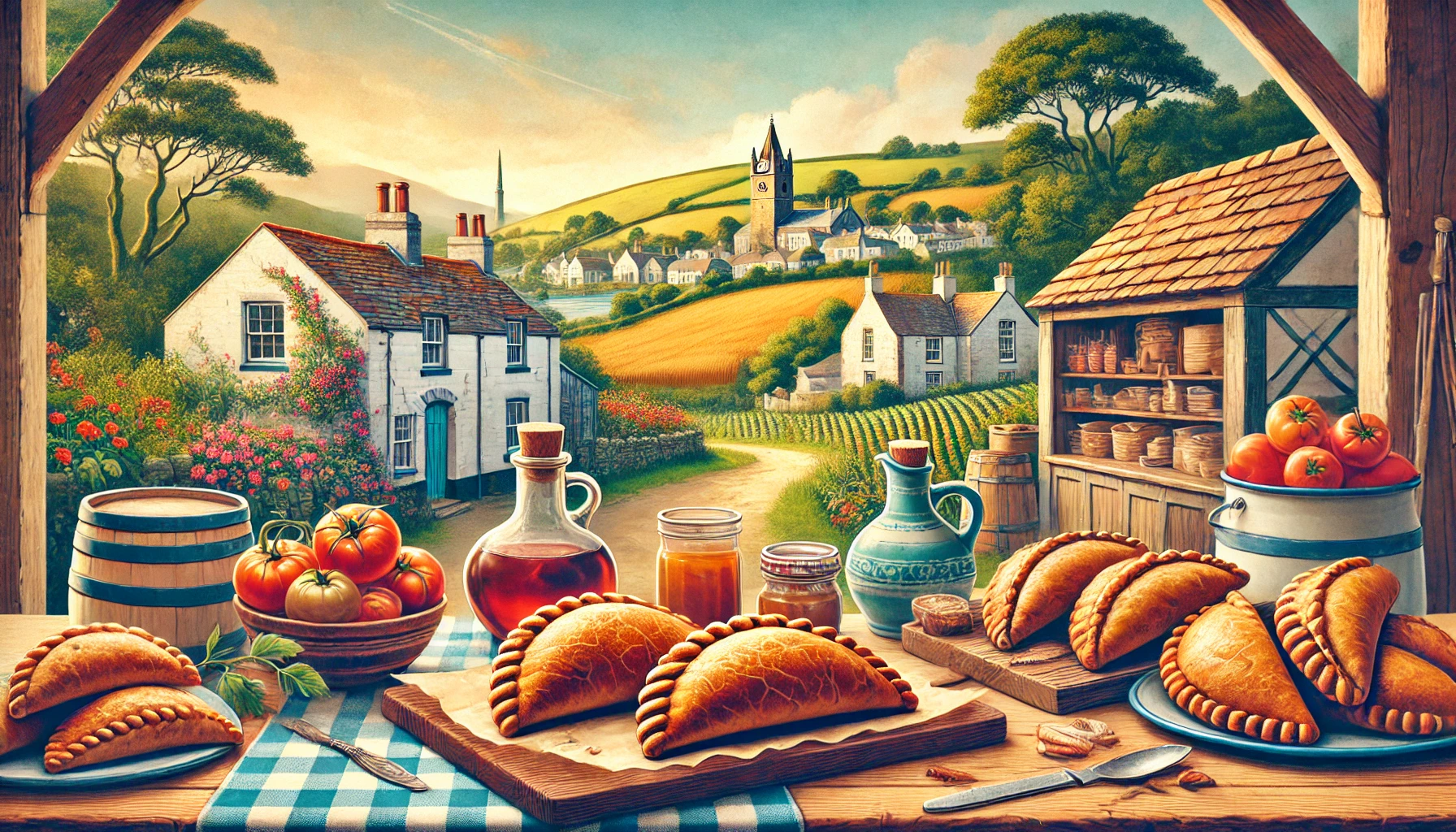The Cornish pasty, a savory pastry filled with meat, vegetables, and seasoning, is a culinary icon of Cornwall. Its rich history, delicious flavors, and cultural significance make it a beloved dish both locally and worldwide. As an English Gen X tech professional with a deep love for Cornwall’s heritage and cuisine, I’m excited to take you on a journey through the history of Cornish pasties, share traditional and modern recipes, and highlight the best spots to enjoy these delectable treats in Cornwall.
Table of Contents
The History of Cornish Pasties
Origins and Evolution
The Cornish pasty has its roots in Cornwall’s mining communities. Dating back to the 13th century, it was initially a meal for Cornish miners, known as “tinners.” The pasty’s robust pastry shell served as a convenient and durable container, keeping the filling warm and protected while allowing miners to hold it with dirty hands. Traditionally, the pasty was filled with beef, potatoes, turnips (also known as swedes), and onions, seasoned simply with salt and pepper.
Cultural Significance
The Cornish pasty is more than just a meal; it symbolizes Cornwall’s heritage and resilience. Recognized with Protected Geographical Indication (PGI) status in 2011, only pasties made in Cornwall following the traditional recipe can be legally called “Cornish pasties.” This designation highlights the importance of the pasty in Cornish culture and helps preserve its authenticity.
The Cornish Pasty Association
The Cornish Pasty Association (CPA) was formed to protect the reputation of the Cornish pasty. The CPA sets strict guidelines for what constitutes a genuine Cornish pasty, including specific ingredients, crimping techniques, and baking methods. Their efforts ensure that the tradition of pasty-making is upheld and celebrated.
Traditional Cornish Pasty Recipe
Ingredients
- 500g (1 lb 2 oz) strong bread flour
- 120g (4 oz) lard or white shortening
- 125g (4½ oz) margarine or butter
- 1 tsp salt
- Cold water
- 350g (12 oz) beef skirt or chuck steak, diced
- 1 large onion, finely chopped
- 1 medium swede (rutabaga), peeled and diced
- 2 potatoes, peeled and thinly sliced
- Salt and pepper to taste
- Beaten egg or milk for glazing
Step-by-Step Instructions
- Make the Pastry: In a large bowl, combine the flour and salt. Rub in the lard and margarine until the mixture resembles breadcrumbs. Add cold water a little at a time, mixing until the dough comes together. Wrap the dough in cling film and refrigerate for at least 30 minutes.
- Prepare the Filling: In a bowl, mix the diced beef, onion, swede, and potatoes. Season generously with salt and pepper.
- Roll Out the Pastry: Preheat the oven to 220°C (425°F). Roll out the dough on a floured surface to about 5mm thick. Cut out circles about 20cm (8 inches) in diameter.
- Assemble the Pasties: Place a portion of the filling on one half of each pastry circle, leaving a border around the edge. Brush the edges with beaten egg or milk, fold the pastry over the filling, and crimp the edges to seal.
- Bake: Place the pasties on a baking sheet and brush the tops with beaten egg or milk. Bake in the preheated oven for 20 minutes, then reduce the heat to 160°C (320°F) and bake for an additional 40 minutes until golden brown.
Tips for the Perfect Pasty
- Use cold ingredients to keep the pastry from becoming too soft.
- Crimp the edges tightly to prevent the filling from leaking.
- For a flakier crust, use a mix of lard and butter in the pastry.
Modern Twists on the Classic Pasty
Vegetarian and Vegan Options
Cornish pasties can be adapted to suit vegetarian and vegan diets without compromising on flavor. Popular fillings include:
- Vegetarian: Cheese and onion, mushroom and spinach, or curried vegetables.
- Vegan: Spiced chickpeas and vegetables, lentil and vegetable stew, or vegan cheese and onion.
Seafood Pasties
Given Cornwall’s rich maritime heritage, it’s no surprise that seafood pasties are a local favorite. Variations include:
- Fish Pasty: Filled with white fish, potatoes, and leeks.
- Crab and Lobster Pasty: A luxurious twist using locally sourced crab and lobster meat.
Sweet Pasties
For those with a sweet tooth, sweet pasties offer a delightful dessert option. Popular fillings include:
- Apple and Cinnamon: Sweet apples with a hint of cinnamon, perfect for a cozy treat.
- Cherry and Almond: Tart cherries paired with nutty almonds for a delicious combination.
The Best Spots to Enjoy Cornish Pasties in Cornwall
Famous Pasty Shops
- Philps Bakery: With locations in Hayle and Marazion, Philps is renowned for its traditional Cornish pasties made with high-quality local ingredients.
- Ann’s Pasties: Founded by Ann Muller, this iconic pasty shop in Helston and The Lizard offers some of the best pasties in Cornwall.
- The Cornish Bakery: With multiple locations across Cornwall, The Cornish Bakery serves up a variety of pasties, from classic to contemporary.
Local Bakeries
- St Agnes Bakery: This family-run bakery in St Agnes offers delicious handmade pasties and other baked goods.
- Pengenna Pasties: Located in Bude, Pengenna Pasties is known for its generous fillings and perfectly crimped pastry.
- Hampsons of Hayle: A hidden gem in Hayle, Hampsons offers a range of traditional and modern pasties.
Hidden Gems
- The Chough Bakery: Nestled in Padstow, The Chough Bakery is famous for its award-winning pasties and friendly service.
- Sarah’s Pasty Shop: Located in Looe, Sarah’s Pasty Shop offers a variety of flavors, including vegetarian and vegan options.
- Lavenders Deli & Bakery: Situated in Penzance, Lavenders is a local favorite for its delicious pasties and artisanal breads.
Personal Insights and Experiences
My First Cornish Pasty
I still remember my first bite of a Cornish pasty, purchased from a small bakery in Looe. The flaky pastry and savory filling were a revelation, and I was instantly hooked. Since then, I’ve made it a point to try pasties from different bakeries across Cornwall, each offering its own unique twist on the classic recipe.
Family Pasty-Making Traditions
Making Cornish pasties has become a cherished family tradition. My father has always made pasties, with all sorts of weird and wonderful fillings. My children loved getting involved, from rolling out the pastry to crimping the edges and the only pasty my wife has ever liked was my Dad’s – but only while pregnant! It’s a wonderful way to spend time together and connect with Cornwall’s culinary heritage.
FAQ
Q: Can I freeze Cornish pasties?
A: Yes, Cornish pasties freeze well. Once baked and cooled, wrap them individually in cling film and store in the freezer. To reheat, bake in a preheated oven at 180°C (350°F) until heated through.
Q: What makes a pasty “Cornish”?
A: A pasty can be called “Cornish” if it is made in Cornwall following the traditional recipe, which includes specific ingredients and crimping techniques. This designation is protected by PGI status.
Q: Are there gluten-free pasties available?
A: Yes, many bakeries in Cornwall offer gluten-free pasties. Be sure to check with the bakery for specific options and availability.
Conclusion
The Cornish pasty is a delicious and iconic symbol of Cornwall’s culinary heritage. Whether you prefer the traditional beef and vegetable filling or enjoy modern variations, there’s a pasty for everyone to savor. By exploring the history, trying out recipes, and visiting some of the best pasty spots in Cornwall, you’ll gain a deeper appreciation for this beloved dish.
References/Resources
- The Cornish Pasty Association: www.cornishpastyassociation.co.uk
- Philps Bakery: www.philpspasties.co.uk
- Ann’s Pasties: www.annspasties.co.uk
- The Cornish Bakery: www.thecornishbakery.com



